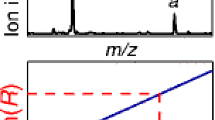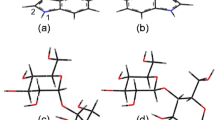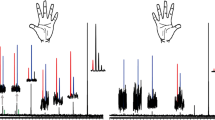Abstract
Enantioselective dissociation in the gas phase is important for enantiomeric enrichment and chiral transmission processes in molecular clouds regarding the origin of homochirality in biomolecules. Enantioselective collision-activated dissociation (CAD) of tryptophan (Trp) and the chiral recognition ability of l-alanine peptides (l-Ala n ; n = 2–4) were examined using a linear ion trap mass spectrometer. CAD spectra of gas-phase heterochiral H+(d-Trp)(l-Ala n ) and homochiral H+(l-Trp)(l-Ala n ) noncovalent complexes were obtained as a function of the peptide size n. The H2O-elimination product was observed in CAD spectra of both heterochiral and homochiral complexes for n = 2 and 4, and in homochiral H+(l-Trp)(l-Ala3), indicating that the proton is attached to the l-alanine peptide, and H2O loss occurs from H+(l-Ala n ) in the noncovalent complexes. H2O loss did not occur in heterochiral H+(d-Trp)(l-Ala3), where NH3 loss and (H2O + CO) loss were the primary dissociation pathways. In heterochiral H+(d-Trp)(l-Ala3), the protonation site is the amino group of d-Trp, and NH3 loss and (H2O + CO) loss occur from H+(d-Trp). l-Ala peptides recognize d-Trp through protonation of the amino group for peptide size n = 3. NH3 loss and (H2O + CO) loss from H+(d-Trp) proceeds via enantioselective CAD in gas-phase heterochiral H+(d-Trp)(l-Ala3) at room temperature, whereas l-Trp dissociation was not observed in homochiral H+(l-Trp)(l-Ala3). These results suggest that enantioselective dissociation induced by chiral recognition of l-Ala peptides through protonation could play an important role in enantiomeric enrichment and chiral transmission processes of amino acids.
Similar content being viewed by others
Introduction
Polypeptides consist of l-amino acids linked through peptide bonds, and can recognize chiral molecules with high sensitivity in proteins. For example, one enantiomer of a chiral drug is highly toxic, while the other is medically effective. The origin of homochirality in biomolecules and the chiral recognition phenomena are key problems in science, and a number of hypotheses for the origin of life have been proposed regarding molecular evolution (Bonner 1991).
Miller synthesized amino acids from simple compounds under conditions that simulated primitive Earth’s atmosphere (Miller 1953). Amino acids were formed by ultraviolet (UV) irradiation of interstellar molecules condensed on a cold surface, suggesting an abiotic formation of amino acids under extraterrestrial conditions (Bernstein et al. 2002; Caro et al. 2002). Dipeptides were also formed in interstellar model ices (Gontareva et al. 2009; Kaiser et al. 2013). However, no enantiomeric enrichment was observed.
A hypothesis for the extraterrestrial origin of biomolecules has been proposed on the basis of several experimental and analytical studies, in which biological molecules were formed in interstellar space and reached Earth (Meinert et al. 2011). The excess l-amino acids found in the Murchison meteorite suggest an extraterrestrial origin of homochirality (Cronin and Pizzarello 1997; Engel and Macko 1997). Observation of the circular polarization of light in star-formation regions implies that enantiomer-selective photodestruction with circular polarized light could induce the excess l-amino acids in interstellar space (Bailey et al. 1998).
The chiral preference of gas-phase serine and proline clusters has been reported using mass spectrometry (Nanita and Cooks 2006; Holliday et al. 2013). We have proposed that the reactivity of size-selected and temperature-controlled gas-phase clusters, consisting of interstellar and biological molecules, is important for understanding the chemical processes in interstellar molecular clouds. We have previously examined the UV photodissociation of temperature-controlled gas-phase tryptophan (Trp) enantiomers, both on a chiral crown ether (Fujihara et al. 2014a, 2015a) and in l-serine (l-Ser) clusters (Fujihara et al. 2014b, 2015b), as a model for interstellar molecular clouds.
Enantioselective photodissociation of gas-phase protonated tryptophan (H+Trp) enantiomers, having NH3 + and COOH groups, on the chiral crown ether has been examined as a function of cluster temperature (Fujihara et al. 2014a, 2015a). The photo-induced hydrogen atom transfer preceded the Cα–Cβ bond cleavage of cold H+(d-Trp) on the chiral crown ether. Above 170 K, the Cα–Cβ bond cleavage of H+(d-Trp) was suppressed gradually with increasing temperature, and no difference in reactivity was observed between the d- and l-enantiomers of H+Trp at 300 K. These temperatures of mass-selected gas-phase cluster ions correspond to those of interstellar to atmospheric molecular clouds. The results indicated that enantioselective photodissociation proceeds at low temperatures, and that hydrogen atom transfer plays an important role in it. The UV photodissociation study of cold gas-phase Trp enantiomers in protonated l-serine clusters H+(l-Ser) m , as a function of cluster size m, showed that when 3 l-Ser units are present in the cluster, the photolytic decomposition of Trp is enantioselective (Fujihara et al. 2014b). These enantioselective dissociations are the transmission of chirality from one type of molecule to another via photodissciation, suggesting that enantioselective photodissociation of gas-phase amino acids on chiral substances could induce enantiomeric enrichment and chiral transmission. Furthermore, we have applied enantioselective photodissociation to quantitative chiral analysis, in which the optical purity of amino acids can be determined by measuring the relative abundance ratio of two fragment ions in a single photodissociation mass spectrum (Fujihara et al. 2015a, b).
In this work, we have examined the enantioselective dissociation and chiral recognition from two viewpoints with respect to molecular evolution. One is the possibility of enantioselective collision-activated dissociation (CAD) of amino acids, as collisional activation is a universal process and enantioselective dissociation is important to formulate a hypothesis for the origin of homochirality in biomolecules. The other is the chiral recognition ability of l-alanine peptides (l-Ala n ), because Ala has a large helix propensity, and a helix with 3.6 residues per turn is a common short-range secondary structure (O’Neil and DeGrade 1990; Scholtz and Baldwin 1992; Myers et al. 1997; Solov’yov et al. 2006; Jarrold 2007). In order to examine enantioselective CAD of amino acids and chiral recognition of l-Ala n , CAD experiments of gas-phase noncovalent complexes of Trp enantiomers with H+(l-Ala n ) were performed as a function of peptide size n, using a linear ion trap mass spectrometer. This was because Trp when noncovalently complexed with the appropriate chiral substances, demonstrated enantioselective photodissociation, as previously reported by our group (Fujihara et al. 2014a, b; Fujihara et al. 2015a, b). On the basis of these results, we have discussed the relationship between enantioselective dissociation of amino acids and chiral recognition of l-alanine peptides.
Methods
d-Trp and l-Trp (purity of both being >98 %) were obtained from Sigma–Aldrich. l-Dialanine (l-Ala-Ala; l-Ala2), l-trialanine (l-Ala-Ala-Ala; L-Ala3), and l-tetraalanine (l-Ala-Ala-Ala-Ala; L-Ala4) were obtained from Bachem. A solution containing 1 mM Trp and 0.5 mM l-Ala n was made in a mixture of water and methanol (50/50, v/v).
A linear ion trap mass spectrometer (LTQ XL, Thermo Fisher) with a dual conversion dynode detector was used in the CAD experiments of mass-selected ions. Gas-phase noncovalent complexes of Trp enantiomers with protonated l-alanine peptides, H+(d-Trp)(l-Ala n ) and H+(l-Trp)(l-Ala n ), were generated using nanoelectrospray ionization, where a voltage of 2.5 kV was applied. The ions were transferred to the gas phase through a heated capillary and ion guides. The capillary temperature and applied voltage were 200 °C and 14 V, respectively. The voltage of the tube lens was 70 V. The ions were mass-selected, dissociated, and mass-analyzed using a linear ion trap (Schwartz et al. 2002). CAD experiments using He collision gas at room temperature were carried out at an activation q z of 0.25 and an activation time of 30 ms. Collision energies were 15 % for n = 2 and 3, and 20 % for n = 4 (normalized collision energy given by the instrument), where the supplemental AC voltages applied across the rods were below 1 V. Other instrumental parameters were multipole 1 offset of −7.6 V, intermultipole lens 1 of −9.4 V, multipole 2 offset of −9.4 V, intermultipole lens 2 of −11.8 V, gate lens of −40.0 V, multipole 3 offset of −15.5 V, front lens of −14.4 V, front section offset of −9.0 V, center section offset of −12.0 V, back section offset of −7.0 V, and back lens of −0.1 V.
Results and Discussion
Figure 1 shows the CAD spectra of heterochiral H+(d-Trp)(l-Ala2) and homochiral H+(l-Trp)(l-Ala2) (m/z 365). H+Trp (m/z 205) and H+(l-Ala2) (m/z 161), observed in the spectra, are formed by evaporation of l-Ala2 and Trp, respectively. H2O-elimination and CH3OH-elimination products are observed at m/z 347 and m/z 333, respectively, which are dissociation pathways in the noncovalent complexes. The CAD spectra at n = 2 show no difference between the d- and l-enantiomers of Trp.
Figure 2 shows the CAD spectra of heterochiral H+(d-Trp)(l-Ala3) and homochiral H+(l-Trp)(l-Ala3) (m/z 436). H+(l-Ala3), formed by evaporation of Trp, is observed at m/z 232 in both spectra. In the heterochiral complex, NH3 loss, CO loss, and (H2O + CO) loss are observed at m/z 419, 408, and 390, respectively, as shown in Fig. 2a. These dissociations in the complex do not occur at n = 2. In contrast to the heterochiral complex, H2O loss, CO loss, and CO2 loss are observed at m/z 418, 408, and 392, respectively, in the CAD spectrum of homochiral H+(l-Trp)(l-Ala3) as shown in Fig. 2b. The product ion at m/z 231, observed in the heterochiral H+(d-Trp)(l-Ala3), is assigned to l-Ala3 +.
In the CAD spectra of heterochiral H+(d-Trp)(l-Ala4) and homochiral H+(l-Trp)(l-Ala4) (m/z 507) shown in Fig. 3, H2O-elimination and CH3OH-elimination products are observed at m/z 489 and m/z 475, respectively, as with n = 2 complexes. The product ion at m/z 377 is assignable to the Cα–Cβ bond cleavage of Trp in the complexes.
The H2O-elimination product is observed in the CAD spectra of both heterochiral and homochiral complexes of n = 2 and 4, and homochiral H+(l-Trp)(l-Ala3). In contrast, H2O loss from the complex does not occur in heterochiral H+(d-Trp)(l-Ala3), where NH3 loss and (H2O + CO) loss are the main dissociation pathways in the complex, as shown in Fig. 2a. H2O loss is the main dissociation pathway of protonated polyalanines in CAD experiments using a quadrupole ion trap mass spectrometer, in which the NH3-elimination product is not observed (Rivera-Tirado and Wesdemiotis 2011). The dehydration takes place at the carbonyl group or amino bond of protonated polyalanines. NH3 loss and (H2O + CO) loss are the primary dissociation pathways in the CAD of protonated tryptophan (m/z 205), in which the H2O-elimination product (m/z 187) is not observed (Lioe and O’Hair 2004; Aribi et al. 2004). The protonation site of protonated tryptophan is the amino group, and the dissociations are induced by proton transfer from the NH3 + group. In collisional activation and photoexcitation, CO2 loss is the dominant dissociation pathway of non-zwitterionic amino acids that have NH2 and COOH groups (Tao et al. 2000; Ehrenfreund et al. 2001; Fujihara et al. 2015b).
The observations of the H2O-elimination product in the CAD spectra indicate that the proton is attached to the L-alanine peptide in both heterochiral and homochiral complexes of n = 2 and 4, and homochiral H+(l-Trp)(l-Ala3). H2O loss occurs from H+(l-Ala n ) in the noncovalent complexes. Only in heterochiral H+(d-Trp)(l-Ala3), the protonation site is the amino group of d-Trp, and NH3 loss from H+(d-Trp) is seen to occur in CAD. l-Alanine peptides recognize d-Trp through the protonation of the amino group, at peptide size n = 3. This chiral recognition through protonation could play an important role in the enantiomeric enrichment and chiral transmission processes. NH3 loss and (H2O + CO) loss from H+(d-Trp) proceeds via enantioselective CAD of heterochiral H+(d-Trp)(l-Ala3) at room temperature. In contrast, no dissociation of l-Trp is observed in homochiral H+(l-Trp)(l-Ala3). The enantiomeric excess of l-Trp via enantioselective CAD of d-Trp induced by the chiral recognition of protonated l-Ala3 in the experimental condition is 30 %, which was derived from the ion intensities shown in Fig. 2. The enantioselective CAD of gas-phase Trp is not a real prebiotic start-up scenario for enantiomeric enrichment due to the presence of l-Ala3. It is an accidental chiral effect, where the chiral influence involves the transmission of chirality from one type of molecule to another via CAD. This type of chiral transmission was also observed in UV photodissociation, as mentioned in the introduction, in which the intramolecular hydrogen atom transfer precedes the enantioselective photodissociation at low temperature (Fujihara et al. 2014a).
In the preliminary CAD experiments for n = 5 and 6, H2O-elimination and CH3OH-elimination products were observed for both heterochiral and homochiral complexes, as is shown for n = 4 (Fig. 3). NH3 loss did not occur in either hetero- or homochiral complexes having n = 5, or in homochiral H+(l-Trp)(l-Ala6). In the CAD spectrum of heterochiral H+(d-Trp)(l-Ala6), the NH3-elimination product was observed at one-third of the ion intensity of the H2O-elimination product. The observation of both H2O loss and NH3 loss in the CAD of heterochiral H+(d-Trp)(l-Ala6) suggests that the proton is attached to l-Ala6 and d-Trp in the noncovalent complex. However, it could not be determined whether there was a coexistence of isomers or if a proton share had occurred between l-Ala6 and d-Trp in the noncovalent complex.
The geometrical structures, in which the proton is attached to the amino group of d-Trp, could be stabilized only in the heterochiral n = 3 noncovalent complex. The structures determined by inter- and intra-molecular hydrogen bonds in the noncovalent complex are important to understand the chiral recognition through protonation and the enantioselective CAD. To reveal the geometrical structures relating to the chiral recognition mechanism, it is necessary to perform photodissociation spectroscopy using a variable wavelength laser system and make direct comparisons with the theoretical calculations for size-selected and temperature-controlled gas-phase noncovalent complexes.
In conclusion, enantioselective CAD, induced by chiral recognition of l-alanine peptides through protonation, could play an important role in enantiomeric enrichment and chiral transmission processes of amino acids in molecular clouds. To understand the origin of homochirality in biomolecules, it is important to investigate enantioselective reactions of biological molecules in gas-phase noncovalent complexes.
References
Aribi HE, Orlova G, Hopkinson AC, Siu KWM (2004) Gas-phase fragmentation reactions of protonated aromatic amino acids: concomitant and consecutive neutral eliminations and radical cation formations. J Phys Chem A 108:3844–3854
Bailey J, Chrysostomou A, Hough JH, Gledhill TM, McCall A, Clark S, Ménard F, Tamura M (1998) Circular polarization in star-formation regions: implications for biomolecular homochirality. Science 281:672–674
Bernstein MP, Dworkin JP, Sandford SA, Cooper GW, Allamandola LJ (2002) Racemic amino acids from the ultraviolet photolysis of interstellar ice analogues. Nature 416:401–403
Bonner WA (1991) The origin and amplification of biomolecular chirality. Orig Life Evol Biosph 21:59–111
Caro GMM, Meierhenrich UJ, Schutte WA, Barbier B, Segovia AA, Rosenbauer H, Thiemann WHP, Brack A, Greenberg JM (2002) Amino acids from ultraviolet irradiation of interstellar ice analogues. Nature 416:403–406
Cronin JR, Pizzarello S (1997) Enantiomeric excesses in meteoritic amino acids. Science 275:951–955
Ehrenfreund P, Bernstein MP, Dworkin JP, Sandford SA, Allamandola LJ (2001) The photostability of amino acids in space. Astrophys J 550:L95–L99
Engel MH, Macko SA (1997) Isotopic evidence for extraterrestrial non-racemic amino acids in the Murchison meteorite. Nature 389:265–268
Fujihara A, Sato T, Hayakawa S (2014a) Enantiomer-selective ultraviolet photolysis of temperature-controlled protonated tryptophan on a chiral crown ether in the gas phase. Chem Phys Lett 610-611:228–233
Fujihara A, Maeda N, Hayakawa S (2014b) Enantiomer-selective photolysis of cold gas-phase tryptophan in L-serine clusters with linearly polarized light. Orig Life Evol Biosph 44:67–73
Fujihara A, Maeda N, Hayakawa S (2015a) Quantitative chiral analysis of tryptophan using enantiomer-selective photolysis of cold non-covalent complexes in the gas phase. J Mass Spectrom 50:451–453
Fujihara A, Maeda N, Hayakawa S (2015b) Enantioselective photolysis and quantitative chiral analysis of tryptophan complexed with alkali-metalized L-serine in the gas phase. Chirality 27:349–352
Gontareva NB, Kuzicheva EA, Shelegedin VN (2009) Synthesis and characterization of peptides after high-energy impact on the icy matrix: preliminary step for further UV-induced formation. Plan Space Sci 57:441–445
Holliday AE, Atlasevich N, Myung S, Plasencia MD, Valentine SJ, Clemmer DE (2013) Oscillations of chiral preference in proline cluster. J Phys Chem A 117:1035–1041
Jarrold MF (2007) Helices and sheets in vacuo. Phys Chem Chem Phys 9:1659–1671
Kaiser RI, Stockton AM, Kim YS, Jensen EC, Mathies RA (2013) On the formation of dipeptides in interstellar model ices. Astrophys J 765:111–119
Lioe H, O’Hair RAJ (2004) Gas-phase reactions of protonated tryptophan. J Am Soc Mass Spectrom 15:65–76
Meinert C, Pd M, d’Hendecourt LLS, Nahon L, Jones NC, Hoffmann SV, Bredehöft JH, Meierhenrich UJ (2011) Photochirogenesis: photochemical models on the absolute asymmetric formation of amino acids in interstellar space. Phys Life Rev 8:307–330
Miller SL (1953) A production of amino acids under possible primitive earth conditions. Science 117:528–529
Myers JK, Pace CN, Scholtz JM (1997) Helix propensities are identical in proteins and peptides. Biochemistry 36:10923–10929
Nanita SC, Cooks RG (2006) Serine octamers: cluster formation, reactions, and implications for biomolecule homochirality. Angew Chem Int Ed 45:554–569
O’Neil KT, DeGrade WF (1990) A thermodynamic scale for the helix-forming tendencies of the commonly occurring amino acids. Science 250:646–651
Rivera-Tirado E, Wesdemiotis C (2011) Fragmentation characteristics of bn (n = 2-15) ions from protonated peptides. Rapid Commun Mass Spectrom 25:2283–2290
Scholtz JM, Baldwin RL (1992) The mechanism of α-helix formation by peptides. Annu Rev Biophys Biomol Struct 21:95–118
Schwartz JC, Senko MW, Syka JEP (2002) A two-dimensional quadrupole ion trap mass spectrometer. J Am Soc Mass Spectrom 13:659–669
Solov’yov IA, Yakubovich AV, Solov’yov AV, Greiner W (2006) Ab initio study of alanine polypeptide chain twisting. Phys Rev E 73:021916–021925
Tao WA, Zhang D, Nikolaev EN, Cooks RG (2000) Copper(II)-assisted enantiomeric analysis of D, L-amino acids using the kinetic method: chiral recognition and quantification in the gas phase. J Am Chem Soc 122:10598–10609
Author information
Authors and Affiliations
Corresponding author
Rights and permissions
About this article
Cite this article
Fujihara, A., Matsuyama, H., Tajiri, M. et al. Enantioselective Collision-Activated Dissociation of Gas-Phase Tryptophan Induced by Chiral Recognition of Protonated l-Alanine Peptides. Orig Life Evol Biosph 47, 161–167 (2017). https://doi.org/10.1007/s11084-016-9511-4
Received:
Accepted:
Published:
Issue Date:
DOI: https://doi.org/10.1007/s11084-016-9511-4







